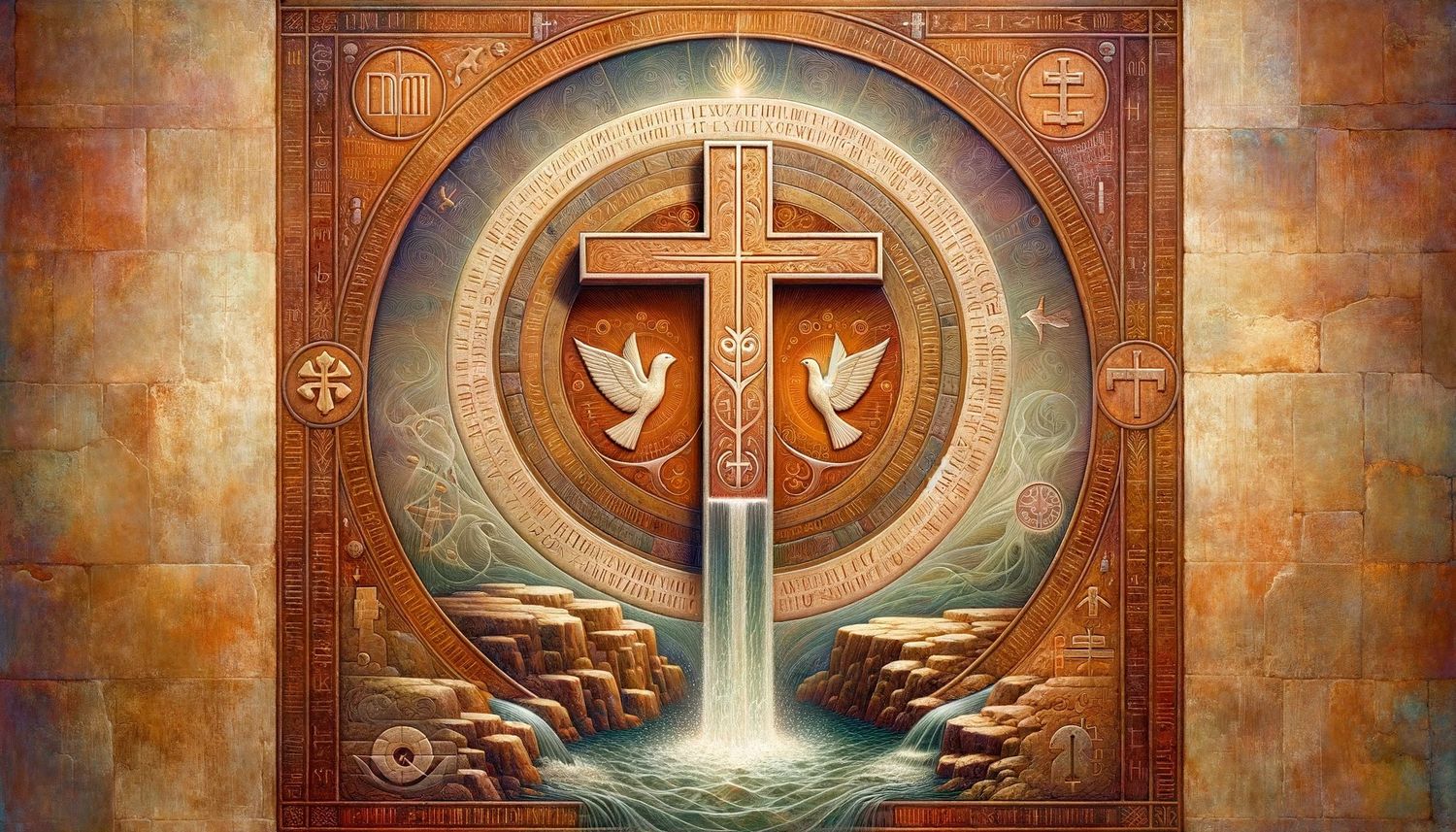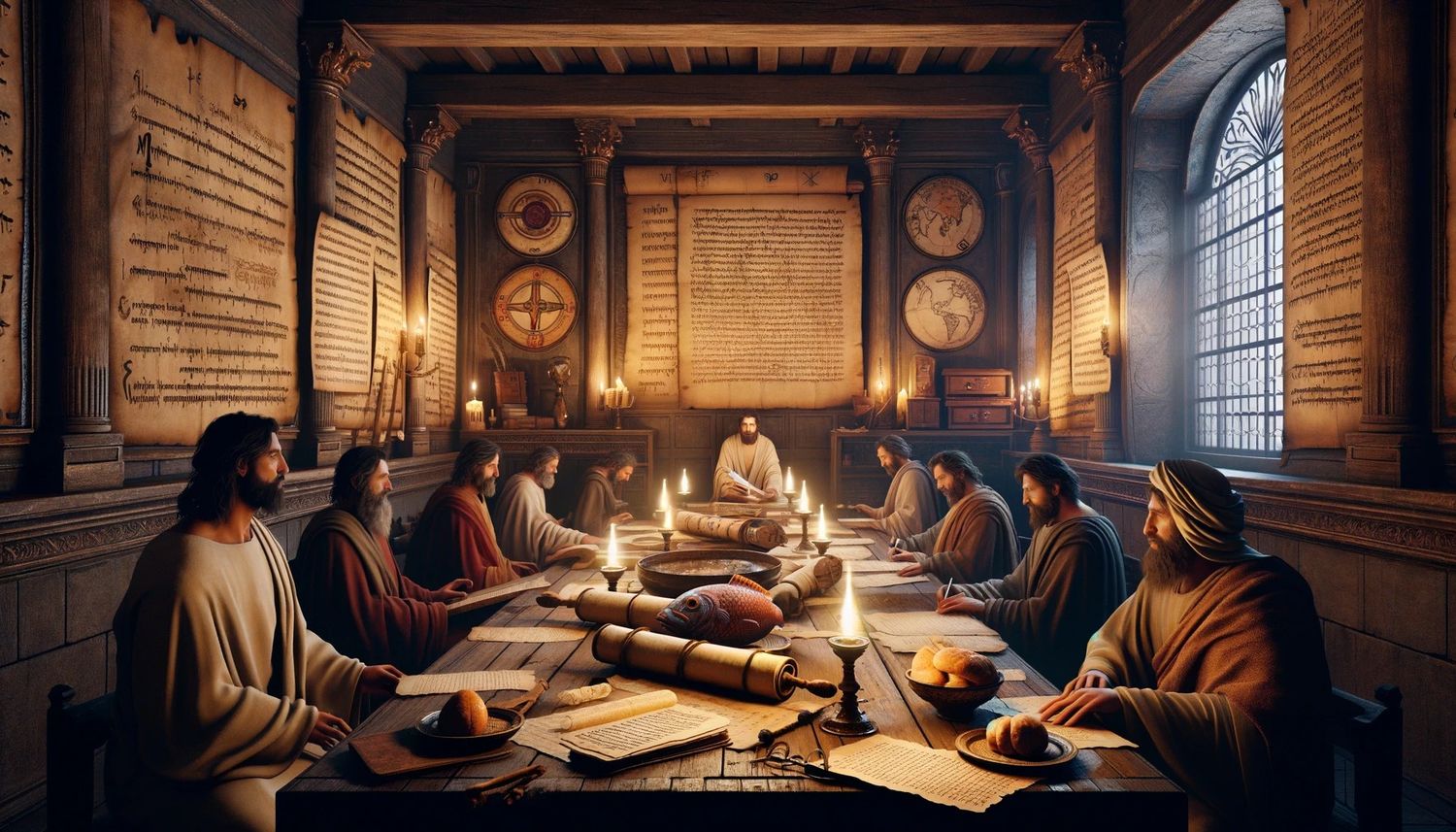Home>Arts and Culture>In What Meter Were The Early Christian Hymns Written?


Arts and Culture
In What Meter Were The Early Christian Hymns Written?
Published: March 7, 2024
Peter Smith, Editorial Director at Christian.net, combines deep insights into faith, politics, and culture to lead content creation that resonates widely. Awarded for his contributions to religious discourse, he previously headed a major organization for religious communicators, enhancing dialogue on faith's societal impacts.
Discover the meter of early Christian hymns and their significance in arts and culture. Uncover the rhythmic patterns that shaped this musical tradition.
(Many of the links in this article redirect to a specific reviewed product. Your purchase of these products through affiliate links helps to generate commission for Christian.net, at no extra cost. Learn more)
Table of Contents
Introduction
What meter were the early Christian hymns written in? This question delves into the fascinating intersection of music, poetry, and religious expression in the early Christian tradition. The study of the meter of early Christian hymns provides valuable insights into the cultural and artistic influences that shaped the development of Christian worship practices. By exploring the historical context and the poetic traditions that influenced early Christian hymnody, we can gain a deeper understanding of the rich tapestry of religious expression in the ancient world.
Read more: When Were The Homeric Hymns Written?
The Influence of Greek and Roman Poetry
The early Christian hymns were deeply influenced by the poetic traditions of ancient Greece and Rome. Greek poetry, with its emphasis on meter, rhythm, and lyrical expression, provided a rich foundation for the development of Christian hymnody. The influence of Greek poetic forms, such as the dactylic hexameter and the elegiac couplet, can be seen in the structure and meter of early Christian hymns. Similarly, Roman poetry, with its focus on the use of language to evoke powerful emotions and convey profound truths, also left a lasting imprint on the development of Christian hymnody.
The poetic techniques and literary devices employed by ancient Greek and Roman poets, such as Homer, Sappho, Virgil, and Ovid, served as a source of inspiration for early Christian hymn writers. The use of vivid imagery, metaphor, and symbolism in Greek and Roman poetry found resonance in the lyrical and evocative language of early Christian hymns. Additionally, the themes of love, loss, redemption, and the divine, which were central to Greek and Roman poetry, also permeated the content of early Christian hymnody, reflecting the continuity of certain spiritual and philosophical ideas across different cultural and religious traditions.
The influence of Greek and Roman poetry on early Christian hymnody underscores the interconnectedness of artistic and religious expression in the ancient world. The blending of poetic forms, literary techniques, and thematic elements from the classical traditions with the emerging Christian faith resulted in the creation of a unique and vibrant body of hymns that reflected the cultural and intellectual milieu of the time. This fusion of artistic and religious influences not only enriched the musical and poetic heritage of Christianity but also contributed to the broader tapestry of human creativity and spiritual expression.
The Development of Christian Hymnody
The development of Christian hymnody was a dynamic and multifaceted process that unfolded over centuries, reflecting the evolving theological, cultural, and musical landscape of the early Christian community. As Christianity emerged as a distinct religious tradition within the diverse tapestry of the ancient world, the practice of communal singing and the composition of hymns became integral to the expression of Christian faith and worship. The early Christians drew upon a rich reservoir of musical and poetic traditions, adapting and transforming existing forms of artistic expression to articulate their beliefs and experiences.
-
Integration of Jewish Psalms: The early Christian hymnody was deeply influenced by the musical and poetic heritage of ancient Judaism, particularly the Psalms. The Psalms, with their lyrical and emotive language, provided a foundational template for the composition of Christian hymns. The themes of praise, lament, thanksgiving, and supplication found in the Psalms resonated with the spiritual aspirations and communal worship practices of the early Christian communities, inspiring the creation of hymns that echoed and expanded upon these themes.
-
Emergence of New Christian Themes: As the Christian community developed its distinct theological identity, new themes and motifs began to permeate the content of hymnody. The life, teachings, and redemptive work of Jesus Christ became central to the lyrical expression of Christian hymns. The hymns celebrated the incarnation, crucifixion, and resurrection of Christ, as well as the hope of salvation and the promise of eternal life. The development of Christian hymnody thus mirrored the theological and doctrinal developments within early Christianity, serving as a vehicle for the articulation and transmission of Christian beliefs and narratives.
-
Influence of Greco-Roman Culture: The cultural milieu of the Greco-Roman world also left an indelible mark on the development of Christian hymnody. The poetic and musical traditions of ancient Greece and Rome, with their emphasis on meter, rhythm, and emotional resonance, informed the structure and style of early Christian hymns. The fusion of Greek and Roman artistic sensibilities with the emerging Christian ethos resulted in the creation of hymns that were both aesthetically compelling and spiritually profound, reflecting the synthesis of diverse cultural influences within the Christian worship tradition.
-
Liturgical Context and Communal Worship: The development of Christian hymnody was intimately connected to the liturgical practices and communal worship of the early Christian assemblies. Hymns were composed and performed as integral components of Christian worship services, contributing to the formation of a shared musical and devotional repertoire within the Christian community. The communal singing of hymns fostered a sense of unity, collective identity, and spiritual solidarity among the early Christians, enriching their worship experience and reinforcing their sense of belonging to a larger faith community.
The development of Christian hymnody thus unfolded within a complex interplay of religious, cultural, and artistic influences, reflecting the creative and adaptive spirit of the early Christian tradition. The rich tapestry of themes, styles, and forms that emerged within early Christian hymnody attests to the enduring power of music and poetry as vehicles for the expression of faith, devotion, and theological reflection within the Christian tradition.
The Meter of Early Christian Hymns
The meter of early Christian hymns reflects the intricate interplay of poetic form, musical rhythm, and religious expression within the context of the burgeoning Christian tradition. Early Christian hymnody drew upon diverse poetic meters and rhythmic patterns, adapting and innovating upon existing literary and musical conventions to give voice to the spiritual aspirations and communal worship practices of the early Christian communities.
Syllabic Verses and Strophic Structure
Early Christian hymns often employed syllabic verses, where each line of the hymn consisted of a fixed number of syllables, contributing to a sense of rhythmic regularity and melodic fluidity in the musical setting of the hymn. The use of syllabic verses allowed for a seamless integration of text and music, enabling the congregation to engage in communal singing with ease and clarity. Additionally, many early Christian hymns exhibited a strophic structure, where multiple stanzas or verses shared the same metrical pattern and musical setting, facilitating congregational participation and memorization of the hymn's lyrics and melody.
Influence of Classical Meters
The meter of early Christian hymns bore the imprint of classical poetic meters, particularly those derived from Greek and Latin poetic traditions. The influence of meters such as the dactylic hexameter, iambic pentameter, and trochaic tetrameter, which were prominent in ancient Greek and Roman poetry, can be discerned in the rhythmic patterns and metrical schemes of early Christian hymnody. The adaptation of classical meters to Christian hymnody not only provided a framework for the organization of poetic and musical elements but also established a continuity with the literary and artistic heritage of the classical world, infusing early Christian hymns with a sense of historical and cultural resonance.
Emphasis on Lyrical Flow and Musical Adaptation
The meter of early Christian hymns prioritized lyrical flow and melodic adaptability, allowing for the seamless integration of text and music within the context of communal worship. The rhythmic patterns of the hymn's meter were carefully crafted to complement the melodic contours of the musical setting, enhancing the expressive and emotive qualities of the hymn's lyrical content. The marriage of poetic meter and musical adaptation in early Christian hymnody exemplified the fusion of verbal and sonic elements in the service of religious devotion and communal singing, underscoring the integral role of music in shaping the aesthetic and spiritual dimensions of Christian worship.
Diversity of Metrical Forms
Early Christian hymnody exhibited a rich diversity of metrical forms, encompassing a range of rhythmic patterns, stanzaic structures, and poetic meters. From the rhythmic simplicity of hymns with regular metrical patterns to the intricate interplay of varied meters in more complex compositions, the meter of early Christian hymns reflected the creative and adaptive spirit of the early Christian communities in crafting musical and poetic expressions of faith. This diversity of metrical forms allowed for the exploration of different emotional and theological themes, enriching the repertoire of Christian hymnody with a multiplicity of rhythmic and lyrical possibilities.
The meter of early Christian hymns thus constituted a vital and dynamic dimension of the evolving tradition of Christian worship, embodying the synthesis of poetic artistry, musical creativity, and religious devotion within the communal life of the early Christian assemblies. The rhythmic and metrical richness of early Christian hymnody continues to resonate through the centuries, bearing witness to the enduring power of music and poetry as vehicles for the expression of faith and spiritual longing within the Christian tradition.
Examples of Early Christian Hymns
-
"Phos Hilaron" (Hail Gladdening Light): This ancient Christian hymn, dating back to the 3rd century, is one of the earliest known Christian hymns outside of the New Testament. The hymn, originally composed in Greek, is a poetic invocation of Christ as the "gladdening light" and the "holy and immortal" one. Its lyrical language and evocative imagery reflect the influence of Greek poetic traditions on early Christian hymnody, while its rhythmic and metrical structure demonstrates the integration of classical poetic forms into Christian worship.
-
"Te Deum" (We Praise You, O God): The "Te Deum" is a venerable Christian hymn of praise and thanksgiving that has been attributed to Ambrose, the 4th-century Bishop of Milan, and Augustine of Hippo. The hymn, originally composed in Latin, is a grand expression of adoration and exaltation, celebrating the majesty and glory of God. Its stately and majestic meter, characterized by its rhythmic solemnity and reverential cadence, exemplifies the fusion of classical poetic meters with Christian theological themes.
-
"Phos Hilaron" (Hail Gladdening Light): This ancient Christian hymn, dating back to the 3rd century, is one of the earliest known Christian hymns outside of the New Testament. The hymn, originally composed in Greek, is a poetic invocation of Christ as the "gladdening light" and the "holy and immortal" one. Its lyrical language and evocative imagery reflect the influence of Greek poetic traditions on early Christian hymnody, while its rhythmic and metrical structure demonstrates the integration of classical poetic forms into Christian worship.
-
"Te Deum" (We Praise You, O God): The "Te Deum" is a venerable Christian hymn of praise and thanksgiving that has been attributed to Ambrose, the 4th-century Bishop of Milan, and Augustine of Hippo. The hymn, originally composed in Latin, is a grand expression of adoration and exaltation, celebrating the majesty and glory of God. Its stately and majestic meter, characterized by its rhythmic solemnity and reverential cadence, exemplifies the fusion of classical poetic meters with Christian theological themes.
-
"Phos Hilaron" (Hail Gladdening Light): This ancient Christian hymn, dating back to the 3rd century, is one of the earliest known Christian hymns outside of the New Testament. The hymn, originally composed in Greek, is a poetic invocation of Christ as the "gladdening light" and the "holy and immortal" one. Its lyrical language and evocative imagery reflect the influence of Greek poetic traditions on early Christian hymnody, while its rhythmic and metrical structure demonstrates the integration of classical poetic forms into Christian worship.
-
"Te Deum" (We Praise You, O God): The "Te Deum" is a venerable Christian hymn of praise and thanksgiving that has been attributed to Ambrose, the 4th-century Bishop of Milan, and Augustine of Hippo. The hymn, originally composed in Latin, is a grand expression of adoration and exaltation, celebrating the majesty and glory of God. Its stately and majestic meter, characterized by its rhythmic solemnity and reverential cadence, exemplifies the fusion of classical poetic meters with Christian theological themes.
These examples of early Christian hymns offer a glimpse into the rich tapestry of poetic and musical expressions that characterized the worship practices of the early Christian communities. Through their lyrical beauty, theological depth, and rhythmic elegance, these hymns continue to resonate as enduring treasures of Christian hymnody, embodying the creative synthesis of ancient poetic traditions with the emerging ethos of Christian worship.
Read more: What Language Were The Gospels Written In?
Conclusion
In conclusion, the meter of early Christian hymns reflects the intricate interplay of poetic form, musical rhythm, and religious expression within the context of the burgeoning Christian tradition. The development of Christian hymnody was a dynamic and multifaceted process that unfolded over centuries, reflecting the evolving theological, cultural, and musical landscape of the early Christian community. The influence of Greek and Roman poetry, the integration of Jewish Psalms, the emergence of new Christian themes, and the liturgical context and communal worship all contributed to the rich tapestry of early Christian hymnody. The examples of early Christian hymns, such as "Phos Hilaron" and "Te Deum," offer a glimpse into the diverse and profound expressions of faith and devotion that characterized the worship practices of the early Christian communities. The meter of early Christian hymns continues to resonate through the centuries, bearing witness to the enduring power of music and poetry as vehicles for the expression of faith and spiritual longing within the Christian tradition.













